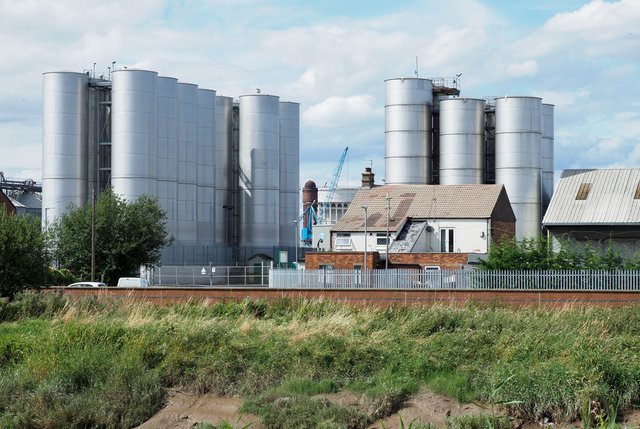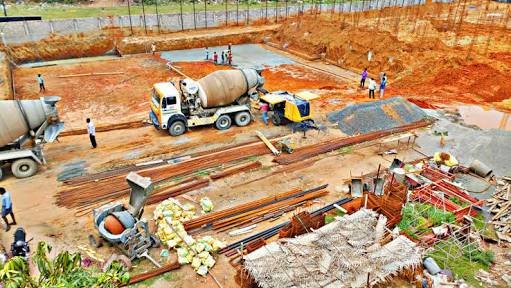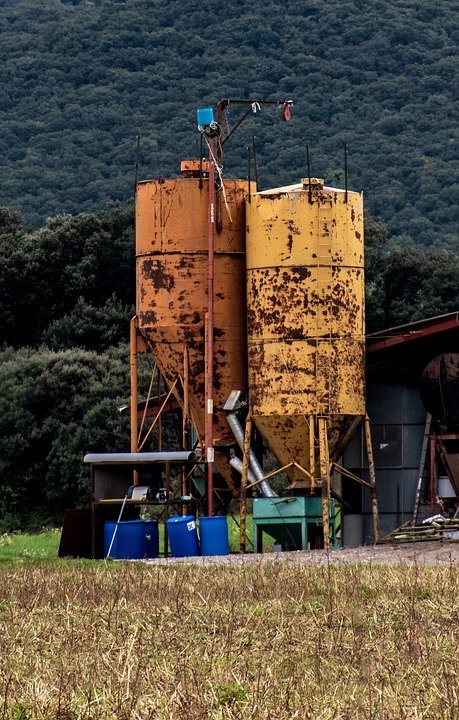Why silos fail

Seasons greetings esteemed readers. It's another beautiful day to put some ink to paper. I'm sure you're doing very fine just like I am here; only for the hamattan that is looking straight at me in the eye here. You wonder what hamattan is, it's just term that typifies the atmospheric condition (dry season) between October and March. Obviously, Christmas always fall during this periods, so there's no harm when you call it 'our winter'. This period is the driest and coldest in Nigeria, irrigation technics are used in growing crops, and other selected crops that can adapt to this weather condition. My lazy self find this season interesting as I can wash my cloths in the evening with no doubt of it getting dry the next morning, with some naturally applied -so to say - 'starch'
As earlier mentioned, not all crops can grow normally with the weather condition but then - Is it a period of rest from hunger? Will the crops less produced not be consumed like any other season? What happens to the prices of these crops in market? Questions on food availability, stability and access comes into play, some of which can be answered by using appropriate tilling machines, Improved agronomic practices, water storage and irrigation technologies, agro-processing technologies, seed and grain drying, aeration and storage technology.

Bulk grain silo [Source: Creative Commons Licence] - ShareAlike 2.0
A typical example of seed and grain storage technology is the silo - a structure for storing grains or fermented feed known as silage. Most silos are steel or reinforced concrete cylindrical structures built on mat foundations or elevated and supported by frames or reinforced concrete columns. You can check for writeups about silos from @sogless.
During my undergraduate days, our lecturers always mentioned to us that in the engineering profession, it's very difficult to hide design mistakes; most especially on the long run. When you don't work within the safety limits or give necessary allowances, failure is certain. Sometimes, the failure only involves distortion or deformation which doesn't seemingly pose a safety or operational hazard. It can also be devastating, in terms of loss of the container, contamination of the agricultural material and most importantly, possible injury or loss of life.
Briefly, I'll share some reasons why these failures occur in silo so as avoid them in the future.
Failures can be as a result of;
- Faulty design
- Errors in construction
- Improper usage
- Poor maintenance culture
Faulty design
The design of silos is primarily governed by the type and properties of the stored material where density, flow and friction properties of various stored materials vary widely. As a result of variation in properties of stored products, silos are designed and evaluated based on material being stored.
When designing silos, most engineers just take into consideration the magnitude and direction of static loads; normal and shear pressure over the height of the wall by stored material and leave out dynamic loads which include seismic and wind loads, stresses created by temperature difference between the silo wall and the stored bulk solids, potential expansion of the stored material. Dynamic loads are very critical in design of silos; they're designs to curb emergencies or anomaly environmental conditions.
Another reason why we have failures is due to poor foundation design and little or no consideration of the supporting soil structure. Silos, are very tall structures with large height to diameter ratio. The weight of the bulk material and the structure produces a huge axial stress at the base of the silo allowing the supporting soil to be subjected to compressive pressure due to applied gravity loads. These compressive pressure can either be uniform which is safe or other wise.
A difference between bunkers and silos is that for silos, h > 1.5√A while its otherwise for bunkers.
A, is the cross sectional area while h, is the height of the silo
.jpeg)
Non uniform placement of products inside the silo can cause a distortion in the pressure bulbs resulting in tilting and collapse. Quick loading of silos constructed on a clay soil results in a compression of the clay soil and water fills the pore spaces between layers of clay particles. The more the water, the less the shear strength of the clay because there won't be enough friction between each clay particles and when the shear stress is more than the designed shear strength, then the soil failure is inevitable
Errors in construction
Selection of right quality material is of utmost importance when constructing any structure. More often than none, we notice how construction firm and workers make unauthorized changes to designs during construction in order to expedite the work or reduce costs. Poor material selection causes thermal ratcheting where walls of metal silos expand during the day and contract at night as the temperature drop.
If there's no significant and corresponding effect on agricultural produce by the temperature variation in terms of expanding and contracting, there will be increased tensile stresses in the wall during contraction everyday and eventually leads to failure of the wall.
Another common failure associated with construction is as a result of poor workmanship. Companies hire short-term unskilled labours without necessary supervision resulting in acummulation of devastating wrong decisions. It should be noted that productivity cannot be achieved by speed and harder work alone without adopting better work practices.
Improper usage
From this writeup, it's obvious that at every stage of a silos life, there can be a mistake or error that most likely lead to failure if care isn't taken. One might just think that after a detailed silo design is well constructed, then failure is no where around (like my friend will say 'the coast is clear').
This is not always the case as I'll highlight some reasons why a silo can fail when not used appropriately. Internal bursting of silo was been reported on a farm because it was used for silage instead of livestock feeds. So its easy to say that when agricultural produce - other than the one in which a silo was designed for - is introduced, obstructions such as arches and ratholes may form during discharge, causing different load and flow pattern (mass amd funnel flow). With pattern change comes wear of silo walls or explosive condition.
In mass flow pattern, every particle is in motion during the discharge. Distribution of residence time in the silo is reduced since all particles move at same speed. This guarantees complete discharge of the silo contents at flow rates that are generally predictable.
Funnel flow pattern is usually characterized in silos having either squat hopper geometry or flat bottoms. Products located at the center of the silo will move much faster than the product located at the sides. This flow pattern type support storage of more products than mass flow silos of the same overall height and diameter.
Poor maintenance
While I enrolled for my internship at IITA, Ibadan, I noticed one thing peculiar to all units on the organisation -a very good maintenance culture. That's one of the factor that has kept the organisation running since it was established in 1967. Several materials are used in making silos and deterioration can set in due to one factor or the other.

Steel silos are especially susceptible to corrosion and subsequent failure; silage acids produced from ensiling process are pain in the neck for conventional cast-in-place, precast concrete and reinforced concrete silos because they decrease the binding strength of cement.
Regular preventative maintenance like periodic inspection- (checking for signs of cracks, distortion and tilting), repair of the walls among others should be carried out as at when due.
In summary, there are a lot of activities going on in the silos other than just intake and discharge of agricutlural produce in the silo. Activities such as temperature variation, consolidation or compaction of products stored, swelling as a result of moisture content of stored products, segregation which can lead to flow blockage, degradation, wear the wall surface due to abrasion to produce same effect as corrosion, impact pressure, wide loads, differential settlement should be of utmost importance to those involved in silo design, contractors and users.
Designs should be sound, with a very good knowledge of the material being handled, dynamic loads should also be catered for during deign. Not just qualified but experience hands should be employed for sonctruction of silos. Proper maintenance of all parts by user is of great importance to ensure longevity. Also before any alteration is to be carried out during silos usage, proper planning should be done so as to determine all parameters that will be affected by the change. Prevention is better than cure! Thank you for your time.
References
- Adem Dogangun et al 2009. Cause of Damage and Failures in Silo Structures. Journal Of Performance Of Constructed Facilities ©ASCE.
- Er. Amit. Bijon Dutta 2013. Study of types of failure in silos. Global research analysis.
- Florea Dinu 2014. Sustainable Constructions Under Natural Hazards and Catastrophic Events. European Erasmus Mundus Master Course.
This post has been voted on by the SteemSTEM curation team and voting trail in collaboration with @utopian-io and @curie.
If you appreciate the work we are doing then consider voting all three projects for witness by selecting stem.witness, utopian-io and curie!
For additional information please join us on the SteemSTEM discord and to get to know the rest of the community!
I don't think I've ever seen a big silo like the type in this picture in Nigeria. I think part of the problem we have in agriculture is post-harvest preservation. Nigeria loses more than 50% of harvested tomato annually. At least the crazy hike in prices of tomato some time earlier this year may have preservation and of course pest damage to blame for that.
Earlier this year? that was 2016 bro! When Tuta absoluta devoured almost all the cultivated tomatoes in the Northern part of the country. That was a pre-harvest attack though.
Time flies when you are having fun :)
This is disheartening!
I don't think we have a silo capacity as big as the first picture but I've seen one like that on the right in Akure, Ondo State. There are about 33 silos in Nigeria and the largest capacity we can boast of is about 100,000 metric tonnes. Fortunately or unfortunately, they've been placed on concession by the Federal Government of recent. Postharvest loss is a big problem to food access and also on an alarming increase in Nigeria. Postharvest losses can be attributed to the lack of appropriate technologies for processing, packaging, and storage; low rate of technology adoption; low research focus on perishable agricultural produce; poor linkages between research and food industries among others. Currently, more than 30% of the food produced for human consumption across Africa is lost. Tomatoes is one of the perishable horticultural crops that we produce and comsume everyday but little is done to add meaningful value or ensure proper storage of the crop. When crops are off season, the prices gets crazy. Reason government should support agricultural reserves, partner with farmers, encourage them in farming by having percentage they'll buy from farmers after harvest so they can store for the rainy days. This encourages farmers to do more since they have assurance of price stability during bountiful harvest and solve problems of marketing. Also there won't be price shock when crops are off season since the government will have them in reserve and sell at subsidised prices. Thank you @greenrun for your comment
Thanks for the detailed reply. The post harvest loss is particularly wasteful and a big loss to farmers. Placed on concession? What does that mean?
Basically, they want to auction/sell it out to individuals/investors since they can't manage it well
Oh, it turns out that government management here is now synonymous with failure.
I am a bit surprised you don't silo's fires. This is something well known especially in the rural zone where I live. Flour dust can easily burn and explode. Don't you have such a thing in Nigeria?
Thank you @lemouth. Thats a big omission on my part. Explosion in silo is another common phenomenon not just where you stay but everywhere and including Nigeria. Agricultural products (here cereals) are composed of carbon, hydrogen, nitrogen, sulfur, oxygen etc, which makes them combustible. Within the silos, there is always air and the stored grain, forms deposited layers of dust. During the operations of loading and unloading, such layers, because of the motion due to the circulation of air, always generate a permanent cloud. The dispersed combustible dust clouds in the air form an explosive atmosphere and if triggered (by friction between the wall and stored products; static electricity), are able to oxidize so fast as to generate an explosion. The smaller the cross sectional area (in this case, flour) the faster its reactivity. Cereals should be stored and handled in a condition lower that the Lower Explosive Limit or higher than the Upper Explosive Limit to prevent explosion.
This is a problem is a result of faulty deisgn and also poor maintenance. Faulty design if dust aspiration systems or a ventilation system at grain transfer points isn't put in place and poor maintenance if routine checkup is not done to ascertain temperature, minimize dust accumulation among others.
Thanks for the clarifications :)
This post contained some typos in its mentions that have been corrected in less than a day. Thank you for your quick edit !
If you found this comment useful, consider upvoting it to help keep this bot running. You can see a list of all available commands by replying with
!help.I've made the correction. Thanks
Dear friend, you do not appear to be following @wafrica. Follow @wafrica to get a valuable upvote on your quality post!
Congratulations @adewumi! You have completed the following achievement on the Steem blockchain and have been rewarded with new badge(s) :
Click here to view your Board
If you no longer want to receive notifications, reply to this comment with the word
STOPDo not miss the last post from @steemitboard:
Hi @adewumi!
Your post was upvoted by Utopian.io in cooperation with @steemstem - supporting knowledge, innovation and technological advancement on the Steem Blockchain.
Contribute to Open Source with utopian.io
Learn how to contribute on our website and join the new open source economy.
Want to chat? Join the Utopian Community on Discord https://discord.gg/h52nFrV
Congratulations @adewumi! You have completed the following achievement on the Steem blockchain and have been rewarded with new badge(s) :
Click here to view your Board
If you no longer want to receive notifications, reply to this comment with the word
STOP